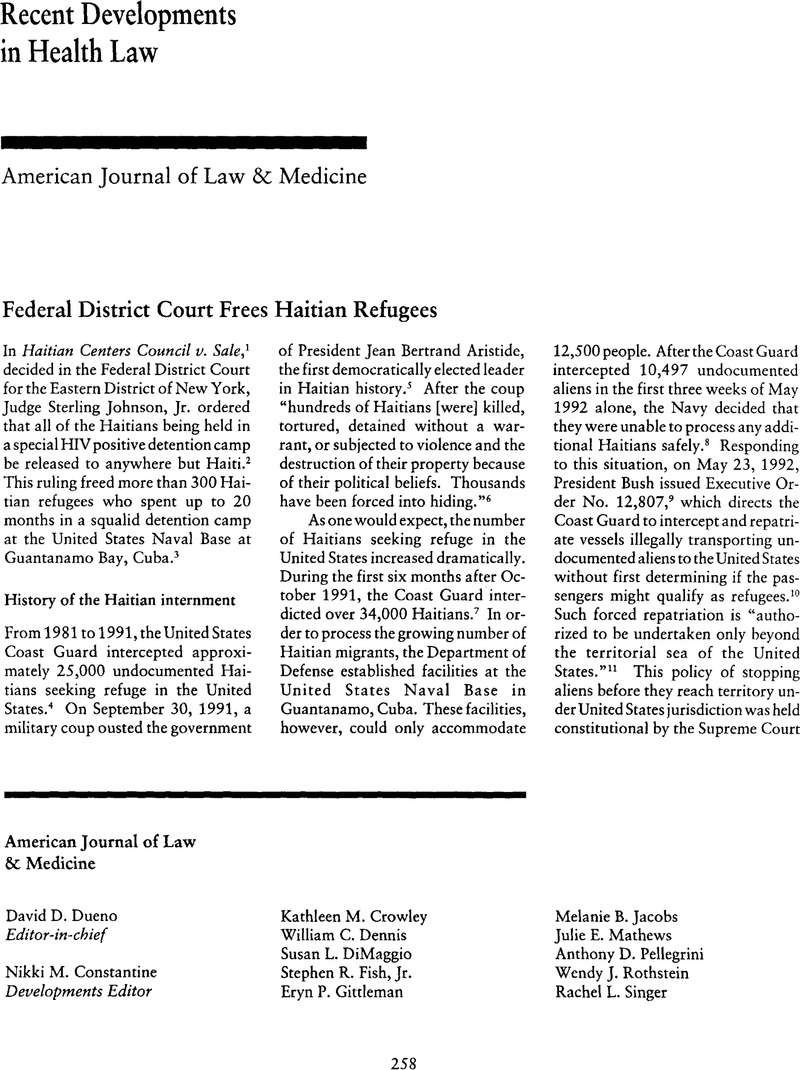No CrossRef data available.
Article contents
Recent Developments in Health Law
Published online by Cambridge University Press: 01 January 2021
Abstract
An abstract is not available for this content so a preview has been provided. Please use the Get access link above for information on how to access this content.

- Type
- Recent Developments in Health Law
- Information
- Copyright
- Copyright © American Society of Law, Medicine and Ethics 1993
References
References
Id. at *7.Google Scholar
Skolnick, Andrew A., Doctors Help HIV-Positive Haitian Refugees Gain Freedom from U.S. Government Detention Camp, 270 JAMA 563, 563 (1993).Google ScholarPubMed
Id. (quoting App. to Pet. for Cert. 144a).Google Scholar
57 Fed. Reg. 21133 (1992).Google Scholar
Sale, 61 U.S.L.W. at 4685.Google Scholar
61 U.S.L.W. 4684 (U.S. June 22, 1993).Google Scholar
Id. at *12.Google Scholar
Id. at *13.Google Scholar
Id. The medical literature is replete with studies documenting the high prevalence of the AIDS virus in Haitians. “Results of cross-sectional serological surveys of Haitian population groups unrelated to AIDS patients provide an index of the level of HIV infection in the community. The overall HIV seroprevalence rate in healthy urban Haitians was 8%.” Pape, Jean W. et al., Prevalence of HIV Infection and High-Risk Activities in Haiti, 3 J. Acquired Immune Deficiency Syndrome 999 (1990).Google ScholarPubMed
Haitian Centers Council, 1993 U.S. Dist. LEXIS 8215 at * 14–15. Rees's memorandum explained the details of this new policy. “Any person ‘screened-in’ as a possible refugee who has been determined to have a communicable disease that is not curable should be given an interview to determine whether he or she is a refugee [within the statutory definition]. In the case of a Haitian national in Guantanamo, this definition requires a finding that the person is unable or unwilling to return to Haiti because of a well-founded fear of persecution on account of race, religion, nationality, membership in a particular social group, or political opinion. This finding is identical to that required to grant asylum or refugee status. The interview should therefore be identical in form and substance, or as nearly so as possible, to those conducted by asylum officers to determine whether asylum should be granted to an applicant already in the United States.” Id. (quoting Memorandum of Grover Joseph Rees, February 29, 1992).Google Scholar
Id. at *16. Although attorneys are regularly present at asylum interviews in the United States, the INS refused to permit counsel for the screened-in plaintiffs' second interviews. At trial, an INS official explained that they refused the Haitians counsel because the lawyers would only emphasize the positive elements of the applicants' cases and downplay the negative elements. Id. The court found that “lawyers serve a necessary and useful purpose in representing an asylum seeker in connection with a well-founded fear of return interview…. The Government's decision to deny Plaintiff Haitian Service Organizations access to Camp Bulkeley is based solely on the content of what they had to say and the viewpoint they would express.” Id.Google Scholar
Id. at *17.Google Scholar
Id. at *20.Google Scholar
Id. at *26–27. “During November 1991—April 1992, approximately 18,000 migrants received medical care from the JTF.” Herip, D.S. & Slaten, D.D., Health Status of Haitian Migrants—U.S. Naval Base, Guantanamo Bay, Cuba, November 1991—April 1992, 42 Morbidity & Mortality Wkly. Rep. 138 (1993).Google Scholar
Haitian Centers Council, 1993 U.S. Dist. LEXIS 8215 at *23. At trial, the government admitted that the medical facilities were not sufficient to treat the patients at a level acceptable in the United States. However, the government expressed no plans to send these ailing individuals to the United States for care. Id. at *24.Google Scholar
Id. at *32. One of the ways government “abridges” expression is by singling out conduct for prohibition “because of the specific message or viewpoint such actions express.” Laurence H. Tribe, American Constitutional Law 789 (1988).Google Scholar
Haitian Centers Council, 1993 U.S. Dist. LEXIS 8215 at *39.Google Scholar
Id. at *42.Google Scholar
Skolnick, , supra note 3, at 563.Google Scholar
References
986 F.2d 1036 (6th Cir. 1993).Google Scholar
Id. at 1037.Google Scholar
42 U.S.C.A. §11101 (1986).Google Scholar
Manion, 986 F.2d at 1038.Google Scholar
Id. at 1037.Google Scholar
Id. at 1037–38 (citing 42 U.S.C.A. § 11112(a) (1986)).Google Scholar
Id. at 1038.Google Scholar
Id. at 1039.Google Scholar
Id. at 1040.Google Scholar
731 F. Supp. 934 (D. Cal. 1990).Google Scholar
42 U.S.C.A. §11113 (1986).Google Scholar
Johnson v. Nyack Hosp., 964 F.2d 116, 123 (2d. Cir. 1992).Google Scholar
References
United States v. Becker, No. 92–2679, 1993 U.S. App. LEXIS 13778 (7th Cir. June 14, 1993).Google Scholar
42 U.S.C.A. § 254d (1991); see also id. § 254e(a)(1) (defining “health professional shortage area”).Google Scholar
Id. § 2541; see also id. § 2541–1 (establishing National Health Service Corps Loan Repayment Program).Google Scholar
Id. § 2541(f).Google Scholar
Id. § 254m(b)(1)(A).Google Scholar
Id. § 254n(a).Google Scholar
Id. § 254m(b)(4).Google Scholar
Id. § 254o(b)(1)(A).Google Scholar
Id. § 254f-1.Google Scholar
No. 92-2679, U.S. App. LEXIS 13778 (7th Cir. June 14, 1993).Google Scholar
Id. at *1.Google Scholar
Id. at *8.Google Scholar
Id. at *9.Google Scholar
Id. at *10; accord United States v. Hugelmeyer, 774 F. Supp. 559 (D. Ariz. 1991).Google Scholar
Becker, U.S. App. LEXIS 13778 at *10.Google Scholar
Id. at *13.Google Scholar
42 U.S.C.A. § 254o (note).Google Scholar
Becker, U.S. App. LEXIS 13778 at *8.Google Scholar
Id. at *15.Google Scholar
944 F.2d 216 (5th Cir. 1991).Google Scholar
879 F.2d 192 (6th Cir. 1989).Google Scholar
972 F.2d 1044 (9th Cir. 1992).Google Scholar
Epstein, Aaron, Doctors Who Renege on Their Vow to Serve, Philadelphia Inquirer, Mar. 10, 1992, at A1.Google Scholar
Blake, W. H. Smith & Gerard, Roy J., Allegiance to the Corps: The Physician's Dilemma, 252 JAMA 3280, 3281 (1984).Google Scholar
Id. at 3281–82.Google Scholar
Id. at 3282.Google Scholar
Rosenblatt, Roger A. et al., Which Medical Schools Produce Rural Physicians? 268 JAMA 1559, 1562–64 (1992).Google ScholarPubMed
Kong, Dolores, U.S. Hopes to Revitalize National Health Service Corps., BOSTON GLOBE, Apr. 19, 1993, at 49.Google Scholar


